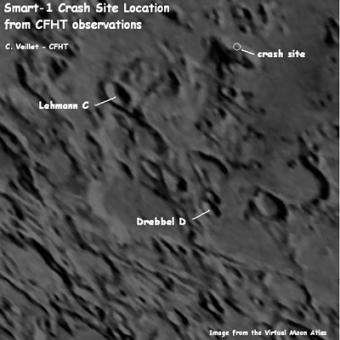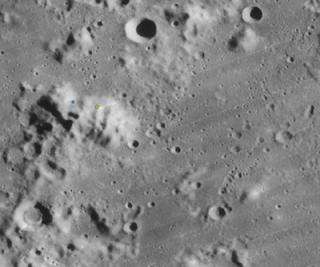This image shows the location of the SMART-1 impact, as estimated by the Canada-France-Hawaii Telescope (CFHT). To determine the location, the CFHT scientists used the position of the flash relative to a pair of reference craters visible as bright areas on the CFHT images, and a map of the Moon as seen from Mauna Kea at the time of the impact using the Moon Virtual Atlas. A simple triangulation allowed to pinpoint the impact area within a couple of kilometres. The crash site determined from the CFHT observations is actually almost coinciding with the last ESA predictions before the impact. Courtesy of CFHT. Credits: Canada-France-Hawaii Telescope / 2006
Timing, location, detection of a flash and of ejected material, and a firework generated by the lunar impact of ESA's SMART-1, are the latest results gathered thanks to the ground observation campaign of this historical event.
"The successful capture of the SMART-1 impact from Earth raised a substantial interest in the amateur and professional astronomical community. They started to reanalyse the available data, to repeat observations of the impact site and to share the results worldwide as a family", says Pascale Ehrenfreund, coordinator of the SMART-1 impact ground observation campaign.
Where did SMART-1 impact the Moon?
"From the various observations and models, we try to reconstruct the 'movie' of what happened to the spacecraft and to the Moon surface," says ESA SMART-1 Project scientist Bernard Foing. "For this lunar 'Crash Scene Investigation', we need all possible Earth witnesses and observational facts." The actual SMART-1 impact took place on 3 September 2006 in the course of the spacecraft's 2890th orbit around the Moon. SMART-1 sent its last signals to Earth at 07:42:21:759 CEST (05:42:21:759 CEST), and the JIVE radio telescope from Hobart, Tasmania, measured a loss of signal a few moments later, at 07:42:22.394 CEST (07:42:22.394 UT).
This image shows a 3D view of the SMART-1 impact location, as generated by USGS scientist Mark Rosiek. The blue star indicates the approximate impact site assuming that the coordinate system used to produce the reference Clementine Base Mosaic is correct. The yellow star indicates the approximate impact site using USGS's lunar control network revised with respect to the Clementine Base Mosaic. The distance separating the blue and yellow stars is about 7 kilometres. In this image North is up. Credits: USGS/ Mark Rosiek
These times are remarkably in agreement with the last SMART-1 flight dynamics predictions of 3 September at 05:42:20 CEST (05:42:20 UT), in the location at 46.20º West longitude and 34.4º South latitude.
This is also in agreement with the coordinates newly derived from the position of the infrared impact flash observed by the Canada-France-Hawaii telescope (CFHT).
Extensive data processing is now going on to specify the topography of the impact site.
From a preliminary analysis of the topographic stereo data available and earlier maps built with SMART-1 data, the satellite should have hit the Moon in the ascending slope of a mountain about 1.5 kilometres high, above the Lake of Excellence plain.
What happened? Dust after the flash
To determine what part of the flash comes from the lunar rock heated at impact or from the volatile substances released by the probe, it is important to obtain measurements in several optical and infrared wavelengths, in addition to the CFHT observations (2.12 microns).
From a detailed analysis of the CFHT infrared movie of the variations after the flash, a cloud of ejected material or debris travelling some 80 kilometres in about 130 seconds has been detected by observer Christian Veillet, Principal Investigator for the SMART-1 impact observations at CFHT.
"It seems that some ejecta or debris made it across the mountain. This is good news to search for the ejecta blanket" says Foing." We might also see the 'firework' expansion of gas and debris that has bounced after impact from the spacecraft."
Some SMART-1 campaign amateurs report that they may have observed the optical flash in their own data, and a possible impact afterglow. "We call for observers to search for the crater and ejecta blankets from SMART-1, in particular using visible or infrared imagery, or even to look at spectroscopic anomalies at the impact site," added Foing. "We also call all observers to send us their reports, thanking them for engaging in the SMART-1 adventure."
Source: European Space Agency

























